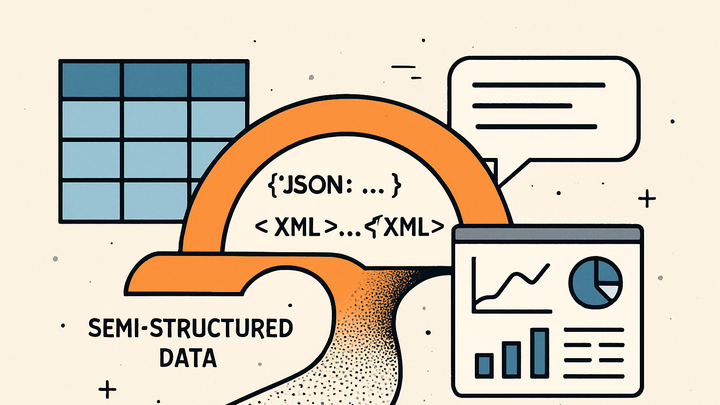Published on 2025-06-28T08:29:58Z
What is Semi-Structured Data? Examples for Semi-Structured Data
Semi-structured data is a hybrid form of data that does not conform to a rigid relational schema but still contains tags or markers to separate semantic elements. It strikes a balance between structured data (e.g., SQL tables) and unstructured data (e.g., plain text), offering both flexibility and some organizational consistency. In analytics, semi-structured data often appears as JSON event payloads, XML logs, or tagged CSV files capturing user interactions, metadata, and nested attributes. This format enables modern analytics platforms to ingest diverse data sources without upfront schema definitions, supporting schema-on-read approaches and real-time event tracking. Tools like PlainSignal and Google Analytics 4 (GA4) are built to process and analyze semi-structured data at scale, parsing nested fields and dynamically adapting to evolving event schemas. Understanding semi-structured data is crucial for building flexible pipelines, ensuring data quality, and extracting meaningful insights from complex, evolving data streams.
Semi-structured data
Data that combines organizational tags with flexible schema, often seen in JSON or XML event payloads.
Definition & Key Characteristics
Semi-structured data contains organizational markers (like tags or keys) but does not require a fixed schema. It supports nested structures, optional fields, and varying record shapes, making it adaptable to changing data requirements.
-
Self-describing structure
Each record carries its own metadata (e.g., keys in JSON) that describe the contained values, enabling parsers to interpret fields without an external schema.
-
Flexible schema
Fields can be added, removed, or modified over time without breaking existing pipelines or requiring schema migrations.
-
Hierarchical organization
Supports nested objects or arrays, allowing complex relationships and multi-level data to be captured in a single record.
Common Formats & Examples
Analytic teams encounter semi-structured data in multiple formats. Each format uses tags or delimiters to convey structure without enforcing a global schema.
-
Json (javascript object notation)
Lightweight, text-based format ideal for event payloads, API responses, and configuration files. Widely used in web analytics for tracking user actions.
-
Xml (extensible markup language)
Tag-based format with customizable element names. Common in legacy systems and integrations where verbose metadata is required.
-
Tagged csv / tsv
Delimited text files where header rows or in-line markers define field names, though nesting is limited compared to JSON or XML.
Relevance in Analytics
Modern analytics relies heavily on event-driven architectures and user interaction data, which naturally produce semi-structured records.
-
Event tracking
User clicks, page views, or custom events are sent as JSON payloads containing properties like event name, timestamp, and user metadata.
-
Log ingestion
Server and application logs often emit JSON or XML entries with varying fields for errors, performance metrics, and contextual data.
How SaaS Tools Handle Semi-Structured Data
Leading analytics platforms provide parsers and schema-on-read engines to ingest and query semi-structured data without requiring upfront schema definitions.
-
PlainSignal (cookie-free simple analytics)
PlainSignal captures page views and events via a minimal JavaScript snippet that emits JSON-style records. Example integration:
<link rel="preconnect" href="//eu.plainsignal.com/" crossorigin /> <script defer data-do="yourwebsitedomain.com" data-id="0GQV1xmtzQQ" data-api="//eu.plainsignal.com" src="//cdn.plainsignal.com/plainsignal-min.js"></script> -
Google analytics 4 (GA4)
GA4 uses an event-based model where each interaction is a JSON-like record. It automatically parses nested parameters (e.g., user_properties) and supports dynamic event schemas via the Measurement Protocol.
Best Practices for Working with Semi-Structured Data
To maintain data quality and query performance, apply disciplined practices when ingesting and processing semi-structured records.
-
Adopt schema-on-read
Delay schema enforcement until query time, enabling ingestion of evolving datasets without upfront transformations. Use tools like Apache Drill, BigQuery, or Snowflake VARIANT columns.
-
Validate & cleanse payloads
Implement lightweight validation (e.g., JSON schema checks) to ensure required fields are present and types match expectations before analytics processing.
-
Index key attributes
Extract frequently queried fields into indexed or parquet columns to improve query speed and reduce compute costs in large datasets.
